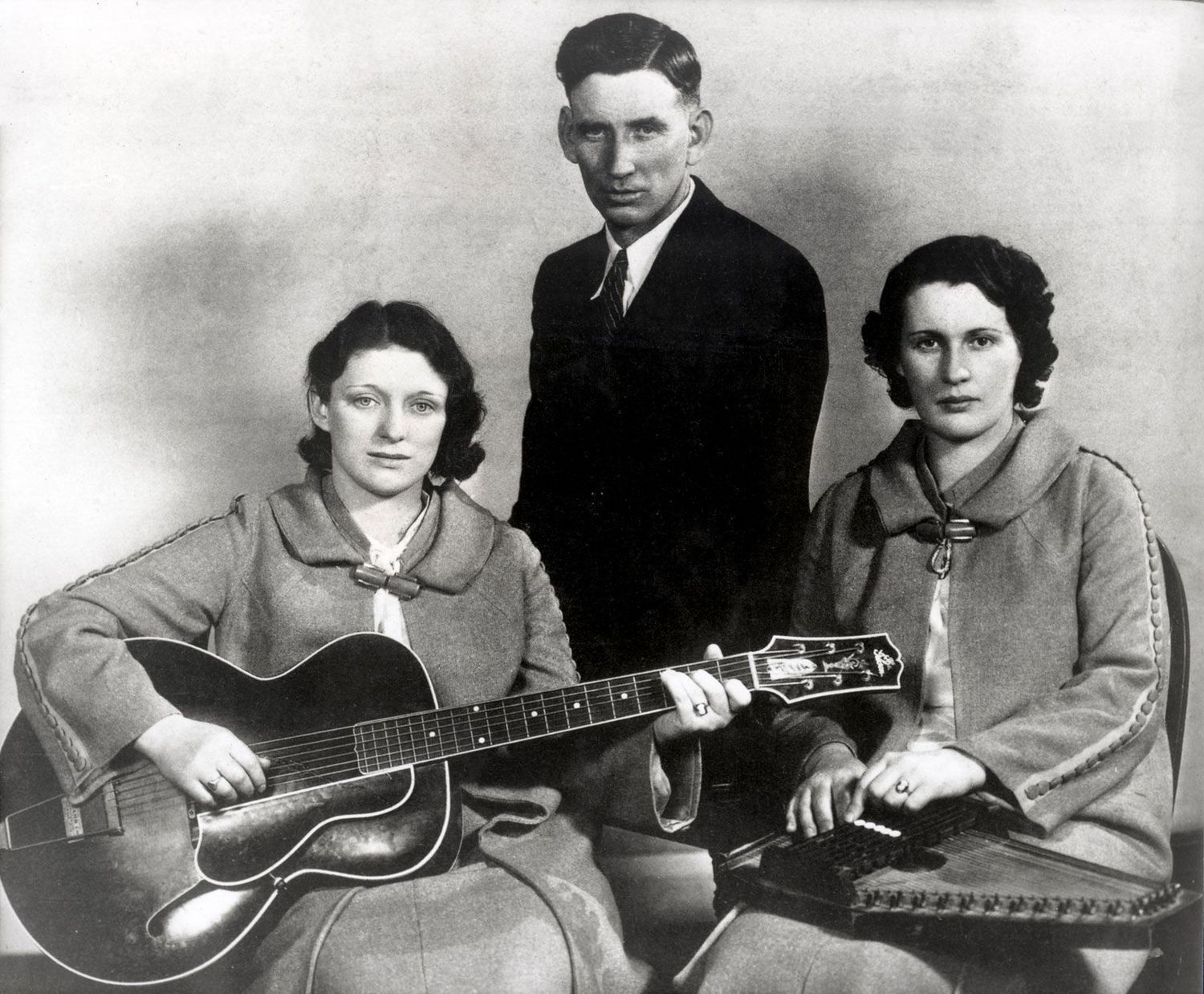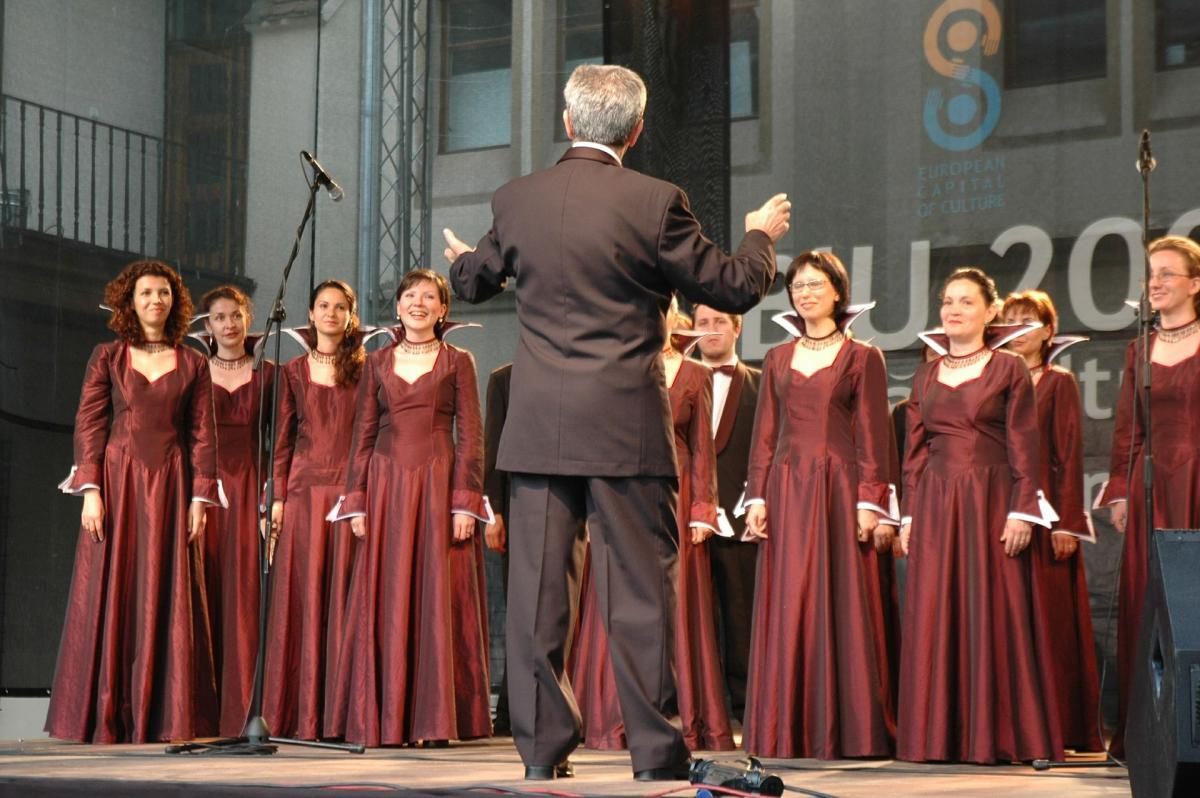Home>Production & Technology>Choir>How To Organize A Women’s Choir


Choir
How To Organize A Women’s Choir
Published: February 22, 2024
Learn how to effectively organize and manage a women's choir with our comprehensive guide. Discover tips, techniques, and strategies for creating a harmonious and successful choir experience.
(Many of the links in this article redirect to a specific reviewed product. Your purchase of these products through affiliate links helps to generate commission for AudioLover.com, at no extra cost. Learn more)
Table of Contents
Introduction
Organizing a women's choir is a rewarding and enriching endeavor that brings together the power of music and the strength of community. Assembling a group of talented and passionate individuals to create beautiful harmonies and melodies can be a fulfilling experience for both the choir members and the audience. Whether you are a seasoned choir director or a newcomer to the world of choral music, establishing and leading a women's choir requires careful planning, dedication, and a deep appreciation for the art of singing.
A women's choir provides a platform for female voices to unite in harmony, expressing a wide range of emotions and narratives through music. The unique timbres and tonal qualities of women's voices offer a captivating and evocative sound that can resonate with audiences on a profound level. From classical compositions to contemporary pieces, a women's choir can explore a diverse repertoire, showcasing the versatility and beauty of the female vocal ensemble.
In addition to the musical aspects, organizing a women's choir involves fostering a supportive and inclusive environment where members can develop their vocal skills, build lasting friendships, and find a sense of belonging. The camaraderie and shared passion for music within the choir create a sense of unity and purpose, enriching the lives of those involved and leaving a lasting impact on the community.
Furthermore, a women's choir can serve as a powerful catalyst for empowerment and self-expression, allowing singers to convey their stories and emotions through the universal language of music. By nurturing creativity and individuality within the choir, members can find a platform to celebrate their unique voices while contributing to a collective artistic vision.
As we delve into the key aspects of organizing and leading a women's choir, we will explore the intricacies of choosing a repertoire, scheduling rehearsals, recruiting members, setting performance goals, managing finances, fostering a positive group dynamic, and collaborating with other choirs. Each of these elements plays a crucial role in shaping a vibrant and successful women's choir, and by delving into these topics, we can gain valuable insights into the art of choral leadership and ensemble management.
Choosing a Repertoire
Selecting a diverse and compelling repertoire is a fundamental aspect of organizing a women's choir. The process of choosing music for the choir's performances involves a thoughtful balance between artistic expression, audience engagement, and the vocal capabilities of the ensemble. A well-crafted repertoire not only showcases the choir's talents but also resonates with the emotions and experiences of both the singers and the audience.
When curating a repertoire for a women's choir, it is essential to consider the unique qualities of the female vocal ensemble. Women's voices possess a rich and resonant timbre, allowing for the exploration of a wide range of musical styles and genres. From classical masterpieces to contemporary arrangements, the repertoire should embrace the diversity of the female vocal range, highlighting its expressive potential and captivating allure.
Furthermore, the selection of music should reflect the choir's artistic vision and thematic cohesion. By choosing pieces that convey a unified narrative or emotional arc, the choir can create a cohesive and immersive musical experience for the audience. Whether exploring themes of empowerment, resilience, love, or the beauty of nature, the repertoire becomes a vehicle for storytelling and emotional connection, transcending linguistic barriers and resonating with listeners on a profound level.
In addition to thematic considerations, the technical complexity and vocal range of the chosen pieces should align with the capabilities of the choir members. It is crucial to select music that challenges and elevates the singers while remaining within a comfortable and achievable range. By striking this balance, the choir can deliver polished and impactful performances, showcasing the depth of their musical prowess and the beauty of their collective voices.
Moreover, incorporating a mix of familiar classics and lesser-known gems can enrich the choir's repertoire, offering a blend of nostalgia and discovery for the audience. Introducing new and innovative arrangements of well-loved songs can infuse the performances with freshness and creativity, while exploring lesser-known compositions can broaden the choir's artistic horizons and introduce audiences to hidden musical treasures.
Ultimately, the process of choosing a repertoire for a women's choir is a harmonious blend of artistic vision, technical consideration, and emotional resonance. By carefully curating a diverse and captivating collection of music, the choir can craft compelling performances that inspire, uplift, and leave a lasting impression on both the singers and their audience.
Scheduling Rehearsals
Scheduling rehearsals for a women's choir is a critical aspect of maintaining a disciplined and productive approach to choral preparation. The efficient allocation of time and resources is essential for honing the choir's vocal skills, refining musical interpretations, and fostering a cohesive ensemble dynamic.
To begin, establishing a regular rehearsal schedule lays the foundation for consistency and progress. By designating specific days and times for rehearsals, choir members can plan their commitments accordingly, ensuring maximum attendance and participation. A well-structured schedule also instills a sense of discipline and commitment within the choir, emphasizing the importance of regular practice and collective dedication to musical excellence.
Furthermore, the duration and frequency of rehearsals should align with the choir's artistic goals and the complexity of the selected repertoire. Balancing the need for thorough preparation with the practical constraints of members' availability is crucial. Longer rehearsals may be necessary when tackling intricate compositions or preparing for upcoming performances, while shorter, focused sessions can be effective for refining specific vocal techniques or addressing musical nuances.
In addition to regular rehearsals, incorporating sectional practices can enhance the choir's overall sound and precision. By dividing the ensemble into smaller groups based on vocal ranges, singers can delve into the intricacies of their individual parts, fine-tuning harmonies, and addressing specific vocal challenges. This targeted approach ensures that each section of the choir achieves a high level of proficiency, contributing to a polished and cohesive choral performance.
Moreover, flexibility within the rehearsal schedule is essential to accommodate unforeseen circumstances and individual needs. Open communication and a willingness to adjust rehearsal times when necessary demonstrate a supportive and empathetic approach to ensemble management, fostering a sense of understanding and cooperation among choir members.
Effective time management during rehearsals is equally vital. Allocating dedicated time for vocal warm-ups, technical exercises, and focused ensemble practice optimizes the efficient use of rehearsal time, allowing the choir to address various aspects of vocal technique and musical interpretation systematically.
By implementing a well-structured and adaptable rehearsal schedule, a women's choir can cultivate a disciplined, cohesive, and musically proficient ensemble, poised to deliver captivating and memorable performances that resonate with audiences and elevate the collective artistry of the choir.
Recruiting Members
Recruiting members for a women's choir is a pivotal step in shaping a vibrant and harmonious ensemble. The process of attracting talented and dedicated individuals to join the choir involves strategic outreach, inclusive communication, and a compelling presentation of the choir's vision and values.
To begin, creating a welcoming and inclusive environment is essential for attracting prospective members. Emphasizing the choir's commitment to diversity, equity, and mutual respect fosters an atmosphere where singers from all backgrounds feel valued and embraced. By highlighting the choir's dedication to inclusivity, potential members are encouraged to join a supportive community where their voices and contributions are celebrated.
Strategic outreach plays a crucial role in recruiting members. Leveraging social media platforms, community events, and local arts organizations can expand the choir's visibility and attract individuals who are passionate about choral music. Engaging in targeted outreach efforts, such as hosting open rehearsals or workshops, provides prospective members with a firsthand experience of the choir's dynamic and collaborative spirit, igniting their interest and enthusiasm for joining the ensemble.
Moreover, clearly articulating the choir's artistic vision and the unique opportunities it offers can inspire prospective members to become part of the musical journey. Communicating the choir's commitment to musical excellence, creative expression, and personal growth resonates with individuals who are eager to contribute their talents to a purpose-driven and artistically fulfilling endeavor.
Highlighting the benefits of joining the choir, such as performance opportunities, vocal training, and the camaraderie of like-minded singers, underscores the value of membership and encourages individuals to become an integral part of the ensemble's collective artistry. Additionally, showcasing the choir's past achievements and impactful performances can demonstrate the profound impact of being a member, compelling prospective singers to join a community dedicated to creating captivating and transformative musical experiences.
By implementing a comprehensive and inclusive approach to member recruitment, a women's choir can attract a diverse and talented ensemble, united by a shared passion for music and a commitment to artistic excellence. Each new member brings a unique voice and perspective, enriching the choir's collective harmony and contributing to its vibrant and inclusive musical tapestry.
Setting Performance Goals
Setting performance goals for a women's choir is a pivotal aspect of cultivating a culture of artistic growth, excellence, and collective achievement. By establishing clear and ambitious objectives, the choir can strive towards elevating its musical prowess, captivating audiences, and leaving a lasting impact on the cultural landscape.
To begin, defining specific and measurable performance goals provides the choir with a roadmap for artistic development and achievement. Whether aiming to stage a series of public concerts, participate in choral competitions, or collaborate with renowned musical ensembles, the clarity of these objectives empowers the choir to focus its efforts and resources towards tangible milestones.
Moreover, aligning performance goals with the choir's artistic vision and thematic direction ensures that each endeavor contributes to a cohesive and impactful narrative. Whether conveying messages of empowerment, resilience, or unity through music, the performance goals become a means of expressing the choir's collective voice and resonating with audiences on a profound emotional level.
Furthermore, setting ambitious yet attainable benchmarks for vocal proficiency, ensemble precision, and audience engagement drives the choir to continuously refine its musical interpretations and stage presence. By striving for excellence in every performance, the choir cultivates a culture of continuous improvement and artistic innovation, inspiring its members to reach new heights of vocal artistry and expressive storytelling.
In addition, incorporating diversity and inclusivity into the performance goals reinforces the choir's commitment to celebrating a wide range of musical genres, cultural influences, and artistic collaborations. By embracing a repertoire that reflects the richness and diversity of the female vocal ensemble, the choir can engage audiences from diverse backgrounds and foster a sense of unity through the universal language of music.
Ultimately, the process of setting performance goals for a women's choir serves as a catalyst for artistic growth, creative expression, and collective achievement. By envisioning and pursuing ambitious milestones, the choir embarks on a transformative journey of musical discovery, leaving an indelible mark on both its members and the communities it touches with its captivating performances.
Managing Finances
Managing the finances of a women's choir is a crucial aspect of ensuring the sustainability and operational efficiency of the ensemble. From securing funds for music purchases and venue rentals to budgeting for promotional materials and guest artist fees, effective financial management is essential for supporting the choir's artistic endeavors and maintaining a thriving musical community.
To begin, creating a comprehensive budget that encompasses both recurring expenses and special projects provides a clear overview of the choir's financial needs. This budget should account for various operational costs, such as music scores, rehearsal space rentals, accompanist fees, and administrative expenses. Additionally, allocating funds for promotional activities, concert production, and educational outreach initiatives ensures that the choir can engage with audiences, attract new members, and contribute to the cultural enrichment of the community.
Moreover, exploring diverse revenue streams, such as ticket sales, fundraising events, and sponsorship opportunities, can bolster the choir's financial stability and expand its resource base. Cultivating partnerships with local businesses, arts organizations, and individual donors can provide valuable financial support while fostering meaningful connections within the community. Additionally, organizing benefit concerts, merchandise sales, and crowdfunding campaigns can mobilize public support and generate vital funds for the choir's activities and initiatives.
Prudent financial planning also involves maintaining transparent and accountable financial records, tracking income and expenses, and adhering to sound financial practices. Implementing financial oversight mechanisms, such as regular budget reviews and internal audits, ensures that the choir operates with fiscal responsibility and integrity, instilling confidence in donors, sponsors, and supporters.
Furthermore, exploring grant opportunities from arts councils, foundations, and cultural institutions can provide the choir with access to additional funding for artistic projects, educational programs, and community outreach initiatives. Crafting compelling grant proposals that articulate the choir's artistic vision, community impact, and innovative programming can position the ensemble as a deserving recipient of financial support, opening doors to new opportunities for artistic growth and community engagement.
By adopting a strategic and proactive approach to financial management, a women's choir can navigate the complexities of budgeting, fundraising, and financial stewardship, empowering the ensemble to pursue its artistic aspirations, engage with diverse audiences, and create resonant and transformative musical experiences.
Creating a Positive Group Dynamic
Fostering a positive group dynamic within a women's choir is foundational to nurturing a supportive and collaborative environment where singers can thrive, connect, and collectively elevate their musical expression. The cultivation of a harmonious and inclusive atmosphere not only enhances the choir's artistic cohesion but also contributes to the well-being and fulfillment of its members.
At the heart of creating a positive group dynamic is the cultivation of mutual respect, empathy, and open communication among choir members. Emphasizing the value of each individual's voice and contribution fosters a sense of belonging and empowerment, allowing singers to express themselves authentically while embracing the collective vision of the ensemble. By fostering an inclusive culture that celebrates diversity and encourages active participation, the choir becomes a nurturing space where members feel valued, understood, and inspired to collaborate towards shared artistic goals.
Furthermore, promoting a spirit of camaraderie and collaboration strengthens the bonds among choir members, creating a sense of unity and purpose that transcends individual differences. Encouraging collaborative decision-making, teamwork, and collective problem-solving nurtures a culture of shared ownership and mutual support, fostering a dynamic where every voice is heard, and every member feels empowered to contribute to the choir's collective success.
In addition to interpersonal dynamics, promoting a culture of continuous learning and growth within the choir reinforces a positive group dynamic. Providing opportunities for vocal workshops, artistic development, and peer mentorship nurtures a culture of continuous improvement and shared artistic exploration. By fostering an environment where members can expand their vocal skills, refine their musical interpretations, and discover new artistic horizons, the choir becomes a dynamic and enriching space for personal and collective growth.
Moreover, celebrating achievements, milestones, and the collective journey of the choir reinforces a positive group dynamic. Recognizing individual and collective successes, whether in rehearsals, performances, or community engagements, instills a sense of pride, motivation, and shared accomplishment among choir members. By acknowledging and celebrating the diverse talents and contributions of each member, the choir cultivates a culture of appreciation and affirmation, nurturing a positive and uplifting group dynamic.
Ultimately, creating a positive group dynamic within a women's choir is a transformative endeavor that goes beyond musical harmony, encompassing empathy, collaboration, and shared artistic growth. By fostering an inclusive, supportive, and empowering environment, the choir becomes a vibrant and nurturing community where voices unite, talents flourish, and collective artistry thrives.
Collaborating with Other Choirs
Collaborating with other choirs presents an exciting opportunity for a women's choir to expand its artistic horizons, forge meaningful connections within the choral community, and create captivating musical experiences that resonate with diverse audiences. By engaging in collaborative endeavors, a women's choir can enrich its repertoire, foster cross-cultural exchange, and contribute to the collective tapestry of choral music.
One of the key benefits of collaborating with other choirs is the opportunity to explore new musical genres and styles. By joining forces with choirs specializing in different musical traditions or vocal techniques, a women's choir can embark on a journey of artistic exploration, broadening its repertoire and infusing its performances with diverse influences. This collaborative exchange of musical traditions can lead to innovative interpretations and transformative artistic experiences, enriching the choir's creative expression and captivating audiences with a rich tapestry of vocal harmonies.
Moreover, collaborating with other choirs provides a platform for cultural exchange and community engagement. Through joint performances, workshops, and cultural events, choirs can celebrate the unique heritage and artistic expressions of diverse communities, fostering a spirit of inclusivity and unity through the universal language of music. This cultural exchange not only enriches the artistic experiences of the participating choirs but also resonates with audiences, promoting understanding, empathy, and celebration of cultural diversity.
Furthermore, collaborative performances with other choirs offer a unique opportunity for singers to develop their ensemble skills and stage presence. By navigating the dynamics of performing alongside different vocal ensembles, choir members hone their adaptability, teamwork, and musical versatility, contributing to a dynamic and polished collective performance. This collaborative synergy not only elevates the artistic quality of the performances but also nurtures a spirit of camaraderie and mutual respect among the participating choirs.
In addition, collaborative projects can amplify the impact of a women's choir within the broader choral community. By partnering with choirs from different regions or backgrounds, the ensemble can extend its reach, engage with new audiences, and contribute to the cultural enrichment of diverse communities. This collaborative outreach not only elevates the choir's visibility and influence but also strengthens the bonds of unity and artistic solidarity within the choral landscape.
In essence, collaborating with other choirs opens a world of artistic possibilities, cultural exchange, and community engagement for a women's choir. By embracing collaborative endeavors, the choir can expand its artistic repertoire, celebrate cultural diversity, and contribute to the collective beauty of choral music, leaving an indelible mark on the hearts of audiences and the choral community at large.
Conclusion
In conclusion, organizing and leading a women's choir is a multifaceted and deeply rewarding endeavor that encompasses the artistry of music, the power of community, and the transformative impact of collective expression. From choosing a diverse and compelling repertoire to fostering a positive group dynamic and collaborating with other choirs, the journey of choral leadership involves a harmonious blend of artistic vision, organizational acumen, and a profound appreciation for the beauty of the female vocal ensemble.
As we reflect on the key aspects of organizing a women's choir, it becomes evident that the process extends far beyond musical performances. It is a journey of nurturing individual voices, fostering a sense of belonging, and creating resonant and transformative musical experiences. The choir becomes a vibrant tapestry of diverse voices united in harmony, weaving together stories, emotions, and shared artistic visions.
Furthermore, the impact of a women's choir extends beyond the confines of rehearsal spaces and concert halls. It resonates within the hearts of audiences, fostering connections, evoking emotions, and celebrating the universal language of music. The choir becomes a beacon of artistic expression, empowerment, and cultural enrichment, leaving an indelible mark on the communities it touches.
In essence, organizing a women's choir is a testament to the enduring power of music to unite, inspire, and elevate the human spirit. It is a celebration of diversity, creativity, and the boundless potential of collective artistic expression. By embracing the intricacies of choral leadership and ensemble management, we embark on a journey of artistic discovery, community engagement, and the timeless beauty of female voices united in harmony.
As we look towards the future, the journey of organizing and leading a women's choir continues to unfold, promising new musical horizons, transformative collaborations, and the enduring resonance of collective voices raised in song. It is a journey that embodies the essence of artistic passion, the spirit of unity, and the profound impact of shared musical experiences, inspiring both the choir members and the communities they touch with the beauty and power of choral music.











